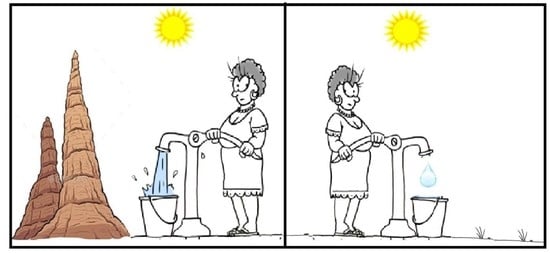Aquifer Potential Assessment in Termites Manifested Locales Using Geo-Electrical and Surface Hydraulic Measurement Parameters
Abstract
1. Introduction
2. Materials and Methods
2.1. Geography and Geological Setting of the Study Area
2.2. Methods
2.2.1. Field Mapping of Termite Mounds
2.2.2. Field Sampling and Experiment
Soil Texture
Bulk Density and Porosity
Soil Water Content
Infiltration Rate
2.2.3. Hydro-Geophysical Survey
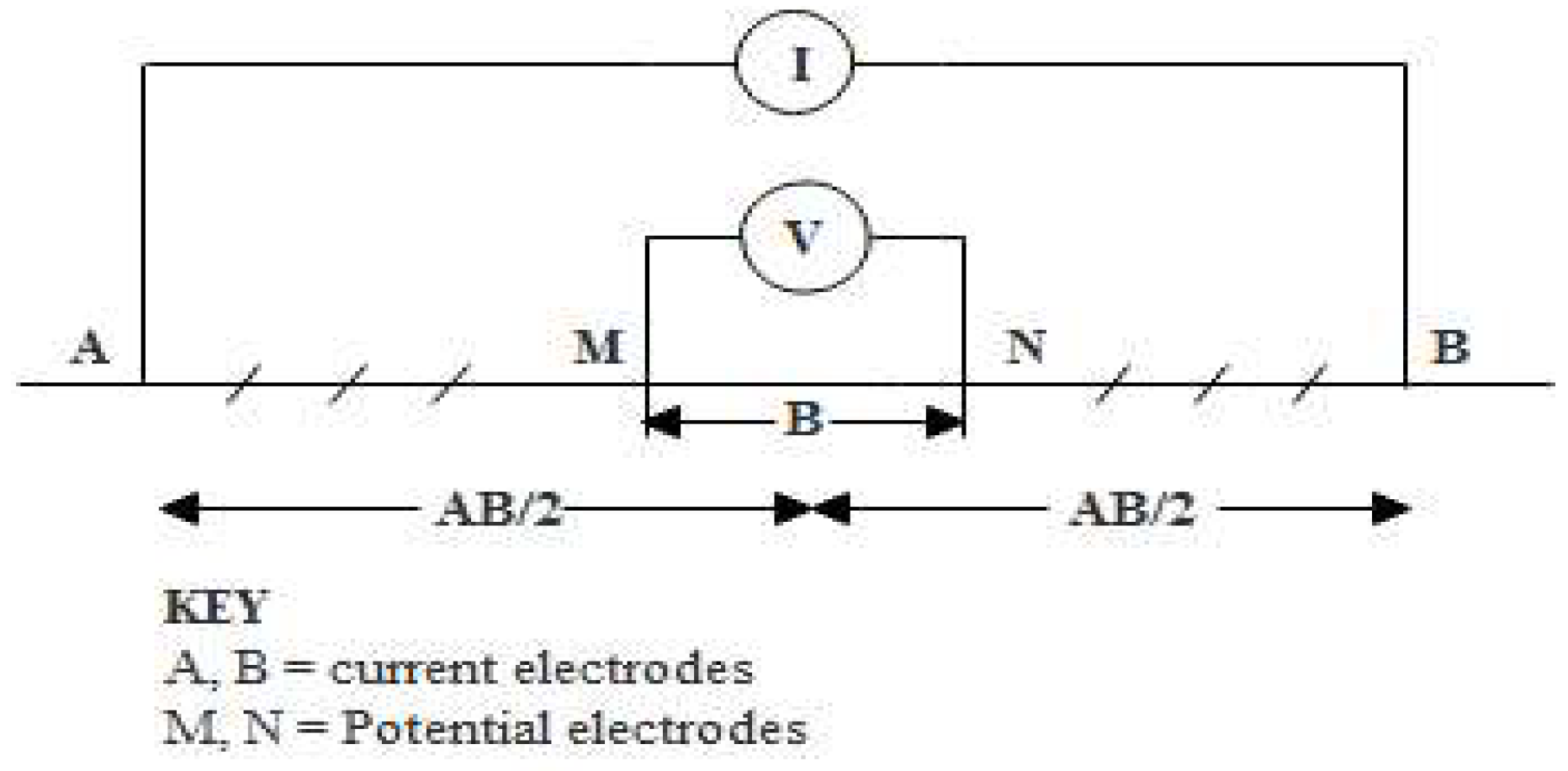
2.2.4. Aquifer Potential Assessment
2.3. Statistical Analysis
3. Results and Discussion
3.1. Soil Physical and Hydraulic Characteristics
3.2. Geo-Electrical Characteristics
3.2.1. Three-Layer Model
3.2.2. Four-Layer Model
3.2.3. Five-Layer Model
3.3. Geo-Electric Layer Correlations with Well-Logs
3.4. Aquifer Potential and Its Spatial Distribution
4. Conclusions
Supplementary Materials
Author Contributions
Funding
Acknowledgments
Conflicts of Interest
References
- Dangerfield, J.M.; Mccarthy, T.S.; Ellery, W.N. The mound-building termite Macrotermes michaelseni as an ecosystem engineer. J. Trop. Ecol. 1998, 14, 507–520. [Google Scholar] [CrossRef]
- Bignell, D.E.; Eggleton, P. Termites in ecosystem. In Termites: Evolution, Sociality, Symbiosis, Ecology; Abe, T., Bignell, D.E., Higashi, H., Eds.; Kluwer Academic Publishers: Dordrecht, The Netherlands, 2000; pp. 363–387. [Google Scholar]
- Bottinelli, N.; Jouquet, P.; Capowiez, Y.; Podwojewski, P.; Grimaldi, M.; Peng, X. Why is the influence of soil macrofauna on soil structure only considered by soil ecologists? Soil Tillage Res. 2015, 146, 118–124. [Google Scholar] [CrossRef]
- Léonard, J.; Rajot, J.L. Influence of termites on runoff and infiltration: Quantification and analysis. Geoderma 2001, 104, 17–40. [Google Scholar] [CrossRef]
- Choosai, C.; Mathieu, J.; Hanboonsong, Y.; Jouquet, P. Termite mounds and dykes are biodiversity refuges in paddy fields in north-eastern Thailand. Environ. Conserv. 2009, 36, 71–79. [Google Scholar] [CrossRef]
- Jouquet, P.; Traoré, S.; Choosai, C.; Hartmann, C.; Bignell, D. Influence of termites on ecosystem functioning. Ecosystem services provided by termites. Eur. J. Soil Biol. 2011, 47, 215–222. [Google Scholar] [CrossRef]
- Moura, E.G.; das CF Aguiar, A.; Piedade, A.R.; Rousseau, G.X. Contribution of legume tree residues and macrofauna to the improvement of abiotic soil properties in the eastern Amazon. Appl. Soil Ecol. 2014, 86, 91–99. [Google Scholar] [CrossRef]
- Turner, J.S. Termites as mediators of the water economy of Arid Savanna ecosystems. In Dryland Ecohydrology; D’Odorico, P., Porporato, A., Eds.; Springer: Dordrecht, The Netherlands, 2006; pp. 303–313. [Google Scholar]
- Davies, A.B.; Baldeck, C.A.; Asner, G.P. Termite mounds alter the spatial distribution of African savanna tree species. J. Biogeogr. 2016, 43, 301–313. [Google Scholar] [CrossRef]
- Lynch, D.K.; Jordan, F. Vegetation Lineaments Near Pearblossom, CA. In Raising Questions in the Central Mojave Desert, Proceedings of the 2013 Desert Symposium, California, USA, 18–21 April 2013; Reynolds, E.R., Ed.; Desert Study Centre: Baker, CA, USA, 2013; pp. 138–145. [Google Scholar]
- Ferriz, H.; Bizuneh, G. Development and management of water resources. In Proceedings of the Ethio-Forum ESRDF: Community Driven Poverty Eradication and Restorative Development in Ethiopia, Adis Ababa, Ethiopia, 15 January–4 February 2002; pp. 361–391. [Google Scholar]
- West, W.F. Some unconventional ideas on prospecting. Chamb. Mines J. 1965, 40–42. [Google Scholar]
- Watson, J.P. The distribution of gold in termite mounds and soils at a gold anomaly in Kalahari sand. Soil Sci. 1972, 113, 317–321. [Google Scholar] [CrossRef]
- Davies, A.B.; Levick, S.R.; Asner, G.P.; Robertson, M.P.; Van Rensburg, B.J.; Parr, C.L. Spatial variability and abiotic determinants of termite mounds throughout a savanna catchment. Ecography 2014, 37, 852–862. [Google Scholar] [CrossRef]
- Ahmed II, J.B.; Pradhan, B. Termite Mounds as Bio-Indicators of Groundwater: Prospects and Constraints. Pertan. J. Sci. Technol. 2018, 26, 479–498. [Google Scholar]
- Mège, D.; Rango, T. Permanent groundwater storage in basaltic dyke fractures and termite mound viability. J. Afr. Earth Sci. 2010, 57, 127–142. [Google Scholar] [CrossRef]
- Bargués Tobella, A.; Reese, H.; Almaw, A.; Bayala, J.; Malmer, A.; Laudon, H.; Ilstedt, U. The effect of trees on preferential flow and soil infiltrability in an agroforestry parkland in semiarid Burkina Faso. Water Resour. Res. 2014, 50, 3342–3354. [Google Scholar] [CrossRef]
- West, W.F. Termite Prospecting. Chamb. Mines J. 1970, 32–35. [Google Scholar]
- Safriel, U.; Adeel, Z.; Niemeijer, D.; Puigdefabregas, J.; White, R.; Lal, R.; Winslow, M.; Ziedler, J.; Prince, S.; Archer, E.; et al. Dryland Systems. In Ecosystems and Human Well-Being: Current State and Trends: Findings of the Condition and Trends Working Group; Hassan, R., Scholes, R., Ash, N., Eds.; Island Press: Washington, DC, USA, 2005; pp. 623–662. [Google Scholar]
- Bosch, C.; Hommann, K.; Rubio, G.M.; Sadoff, C.; Travers, L. Water, Sanitation and Poverty; World Bank: Washington, DC, USA, 2001. [Google Scholar]
- Liu, W.; Zhao, M.; Xu, T. Water Poverty in Rural Communities of Arid Areas in China. Water 2018, 10, 505. [Google Scholar] [CrossRef]
- Dowuona, G.N.N.; Atwere, P.; Dubbin, W.; Nude, P.M.; Mutala, B.E.; Nartey, E.K.; Heck, R.J. Characteristics of termite mounds and associated Acrisols in the coastal savanna zone of Ghana and impact on hydraulic conductivity. Nat. Sci. 2012, 04, 423–437. [Google Scholar] [CrossRef]
- Peel, M.C.; Finlayson, B.L.; Mcmahon, T.A. Updated world map of the Koppen-Geiger climate classification. Hydrol. Earth Syst. Sci. 2007, 11, 1633–1644. [Google Scholar]
- Lyam, A. Nasarawa State. In Nigeria: Survey of States; Mamman, A.B., Oyebaji, J.O., Peters, S.W., Eds.; Federal Ministry of Information: Abuja, Nigeria, 2000; pp. 382–392. [Google Scholar]
- Mahmud, A.; Achide, A.S. Analysis of Land use/Land cover changes to monitor urban sprawl in Keffi-Nigeria. Environ.Res. J. 2012, 6, 130–135. [Google Scholar]
- Anudu, G.K.; Essien, B.I.; Obrike, S.E. Hydrogeophysical investigation and estimation of groundwater potentials of the Lower Palaeozoic to Precambrian crystalline basement rocks in Keffi area, north-central Nigeria, using resistivity methods. Arab. J. Geosci. 2014, 7, 311–322. [Google Scholar]
- Obaje, N.G.; Nzegbuna, A.I.; Moumouni, A.; Ukaonu, C.E. Geology and Mineral Resources of Nasarawa State, 1st ed.; Department of Geology and Mining, Nasarawa State University, Keffi: Keffi, Nigeria, 2005; pp. 1–16. [Google Scholar]
- Obaje, N.G. Geology and Mineral Resources of Nigeria, 1st ed.; Springer: Berlin/Heidelberg, Germany, 2009; pp. 1–100. [Google Scholar]
- Jatau, B.S.; Bajeh, I. Hydrogeological appraisal of parts of Jemaa Local Government Area, North-Central Kaduna State, Nigeria. Res. J. Appl. Sci. 2007, 2, 1174–1181. [Google Scholar]
- Adeyemo, I.A.; Omosuyi, G.O.; Ojo, B.T.; Adekunle, A. Groundwater Potential Evaluation in a Typical Basement Complex Environment Using GRT Index—A Case Study of Ipinsa-Okeodu Area. J. Geosci. Environ. Prot. 2017, 5, 240–251. [Google Scholar] [CrossRef]
- Bayewu, O.O.; Oloruntola, M.O.; Mosuro, G.O.; Laniyan, T.A.; Ariyo, S.O.; Fatoba, J.O. Geophysical evaluation of groundwater potential in part of southwestern Basement Complex terrain of Nigeria. Appl. Water Sci. 2017, 7, 4615–4632. [Google Scholar] [CrossRef]
- Edet, A.E.; Okereke, C.S. Delineation of shallow groundwater aquifers in the coastal plain sands of Calabar area (Southern Nigeria) using surface resistivity and hydrogeological data. J. Afr. Earth Sci. 2002, 35, 433–443. [Google Scholar] [CrossRef]
- Fenta, A.A.; Kifle, A.; Gebreyohannes, T.; Hailu, G. Spatial analysis of groundwater potential using remote sensing and GIS-based multi-criteria evaluation in Raya Valley, northern Ethiopia. Hydrogeol. J. 2014, 23, 195–206. [Google Scholar] [CrossRef]
- Naghibi, S.A.; Pourghasemi, H.R. Comparative assessment between three machine learning models and their performance comparison by bivariate and multivariate statistical methods in groundwater potential mapping. Water Resour. Manag. 2015, 29, 5217–5236. [Google Scholar] [CrossRef]
- Kordestani, M.D.; Naghibi, S.A.; Hashemi, H.; Ahmadi, K.; Kalantar, B. Groundwater potential mapping using a novel data-mining ensemble model. Hydrogeol. J. 2018, 1–14. [Google Scholar] [CrossRef]
- Beretta, A.N.; Silbermann, A.V.; Paladino, L.; Torres, D.; Bassahun, D.; Musselli, R.; García-Lamohte, A. Soil texture analyses using a hydrometer: Modification of the Bouyoucos method. Cienc. Investig. Agrar. 2014, 41, 25–26. [Google Scholar] [CrossRef]
- Hamzah, U.; Malin, E.; Samsudin, A.R. Groundwater investigation in Kuala Selangor using vertical electrical sounding (VES) surveys. Environ. Geol. 2007, 51, 1349–1359. [Google Scholar] [CrossRef]
- Bibby, H.M.; Risk, G.F.; Caldwell, T.G.; Heise, W. Investigations of deep resistivity structures at the Wairakei Geothermal field. Geothermics 2009, 38, 98–107. [Google Scholar] [CrossRef]
- Gopinath, G.; Seralathan, P. Vertical electrical soundings for delineation of groundwater prospect zone in a crystalline terrains of the muvattupuzha river basin, Kerala, India. ISH J. Hydraul. Eng. 2004, 10, 71–82. [Google Scholar] [CrossRef]
- Suneetha, N.; Gupta, G.; Laxminarayana, M. Evaluation of geoelectric parameters to delineate the subsurface fractures for groundwater exploration around coastal Maharashtra, India. J. Coast. Sci. 2017, 4, 9–16. [Google Scholar]
- Adji, T.N.; Sejati, S.P. Identification of groundwater potential zones within an area with various geomorphological units by several field parameters and a GIS approach in Kulon Progo Regency, Java, Indonesia. Arab. J. Geosci. 2014, 7, 161–172. [Google Scholar] [CrossRef]
- Alhassan, U.D.; Obiora, D.N.; Okeke, F.N. The assessment of aquifer potentials and aquifer vulnerability of the assessment of aquifer potentials and aquifer vulnerability of Southern Paiko, North central Nigeria, using geoelectric method. Glob. J. Pure Appl. Sci. 2015, 21, 51–70. [Google Scholar]
- Panthulu, T.V.; Krishnaiah, C.; Shirke, J.M. Detection of seepage paths in earth dams using self-potential and electrical resistivity methods. Eng. Geol. 2001, 59, 281–295. [Google Scholar] [CrossRef]
- Caris, J.P.T.; Van Asch, T.W.J. Geophysical, geotechnical and hydrological investigations of a small landslide in the French Alps. Eng. Geol. 1991, 31, 249–276. [Google Scholar] [CrossRef]
- Larisa, G.; Antonina, P.; Anatoly, P.A. Vertical Electrical Sounding Method for Agricultural Soil Survey. In Application of Geophysics to Engineering and Environmental Problems, Proceedings of the 24th SAGEEP Conference, Charleston, SC, USA, 10–14 April 2011; Bradley, J.C., Ed.; Environment and Engineering Geophysical Society: Denver, CO, USA, 2001. [Google Scholar]
- Choudhury, K.; Saha, D.K.; Chakraborty, P. Geophysical study for saline water intrusion in a coastal alluvial terrain. J. Appl. Geophys. 2001, 46, 189–200. [Google Scholar] [CrossRef]
- Soupios, P.; Papadopoulos, I.; Kouli, M.; Georgaki, I.; Vallianatos, F.; Kokkinou, E. Investigation of waste disposal areas using electrical methods: A case study from Chania. Environ. Geol. 2007, 1249–1261. [Google Scholar] [CrossRef]
- Zohdy, A.A.R.; Eaton, G.P.; Mabey, D.R. Application of surface geophysics to groundwater investigations. In USGS-TWRA, Book 2; US Geological Survey: Reston, VA, USA, 1974. [Google Scholar]
- Alhassan, U.D.; Obiora, D.N.; Okeke, F.N. Geoelectrical investigation of groundwater potentials of northern Paiko, Niger State, North Central Nigeria. J. Earth Sci. 2017, 28, 103–112. [Google Scholar] [CrossRef]
- Mogaji, K.A. Geoelectrical parameter-based multivariate regression borehole yield model for predicting aquifer yield in managing groundwater resource sustainability. J. Taibah Univ. Sci. 2016, 10, 584–600. [Google Scholar] [CrossRef]
- Barker, R.; Blunk, I.; Smith, I. Geophysical consideration in the design of UK National Resistivity Sounding Database. First Break 1999, 14, 45–53. [Google Scholar] [CrossRef]
- Sabet, M.A. Vertical Electrical Resistivity Soundings to Locate Ground Water Resources: A Feasibility Study; Virginia Water Resources Research Center: Blacksburg, VA, USA, 1975; pp. 1–65. [Google Scholar]
- Olayinka, A.I. Non uniqueness in the interpretation of bedrock resistivity from sounding curves and its hydrological implications. Water Resour. J. NAH 1996, 7, 55–60. [Google Scholar]
- Olayinka, A.I.; Akpan, E.J.; Magbagbeola, O.A. Geoelectric sounding for estimating aquifer potential in the crystalline basement area around Shaki. Water Resour. J. NAH 1997, 8, 71–81. [Google Scholar]
- Mujinya, B.B.; Van Ranst, E.; Verdoodt, A.; Baert, G.; Ngongo, L.M. Termite bioturbation effects on electro-chemical properties of Ferralsols in the Upper Katanga (D.R. Congo). Geoderma 2010, 158, 233–241. [Google Scholar] [CrossRef]
- Jouquet, P.; Bottinelli, N.; Shanbhag, R.R.; Bourguignon, T.; Traoré, S.; Abbasi, S.A. Termites: The neglected soil engineers of tropical soils. Soil Sci. 2016, 181, 157–165. [Google Scholar] [CrossRef]
- Adhikary, N.; Erens, H.; Weemaels, L.; Deweer, E.; Mees, F.; Mujinya, B.B.; Baert, G.; Boeckx, P.; Van Ranst, E. Effects of Spreading Out Termite Mound Material on Ferralsol Fertility, Katanga, D.R. Congo. Commun. Soil Sci. Plant Anal. 2016, 47, 1089–1100. [Google Scholar] [CrossRef]
- Roose-Amsaleg, C.; Mora, P.; Harry, M. Physical, chemical and phosphatase activities characteristics in soil-feeding termite nests and tropical rainforest soils. Soil Biol. Biochem. 2005, 37, 1910–1917. [Google Scholar] [CrossRef]
- Seymour, C.L.; Joseph, G.S.; Makumbe, M.; Cumming, G.S.; Mahlangu, Z.; Cumming, D.H.M. Woody species composition in an African savanna: Determined by centuries of termite activity but modulated by 50 years of ungulate herbivory. J. Veg. Sci. 2016, 27, 824–833. [Google Scholar] [CrossRef]
- Jouquet, P.; Tessier, D.; Lepage, M. The soil structural stability of termite nests: Role of clays in Macrotermes bellicosus (Isoptera, Macrotermitinae) mound soils. Eur. J. Soil Biol. 2004, 40, 23–29. [Google Scholar] [CrossRef]
- Lavelle, P.M.; Dangerfield, C.; Frasgoso, V.; Eschnebrenner, D.L.; Hernadez, B.; Pashanari, B.L. The relationship between soil macrofauna and tropical soil fertility. In The Biological Management of Tropical Soil Fertility; Woomer, P.L., Swift, M.J., Eds.; John Wiley & Sons: West Sussex, UK, 1994; pp. 137–169. [Google Scholar]
- Ackerman, I.L.; Teixeira, W.G.; Riha, S.J.; Lehmanna, J.; Fernandes, E.C.M. The impact of mound-building termites on surface soil properties in a secondary forest of Central Amazonia the impact of mound-building termites on surface soil. Appl. Soil Ecol. 2007, 37, 267–276. [Google Scholar] [CrossRef]
- Flóvenz, Ó.G.; Hersir, G.P.; Saemundsson, K.; Ármannsson, H.; Fridriksson, T. Geothermal Energy Exploration Techniques. In Comprehensive Renewal Energy; Sayigh, A., Ed.; Elsevier: Oxford, UK, 2012; pp. 51–95. [Google Scholar]
- Nimmo, J.R. Porosity and pore-size distribution. In Reference Module in Earth Systems and Environmental Sciences; Elsevier: Amsterdam, The Netherlands, 2013; pp. 1–10. [Google Scholar]
- Traoré, S.; Tigabu, M.; Ouedraogo, S.J.; Boussim, J.L.; Guinko, S.; Lepage, M. Macrotermes mounds as sites for tree regeneration in a Sudanian woodland (Burkina Faso). Plant Ecol. 2008, 198, 285–295. [Google Scholar] [CrossRef]
- Abe, S.S.; Wakatsuki, T. Possible influence of termites (Macrotermes bellicosus) on forms and composition of free sesquioxides in tropical soils. Pedobiology 2010, 53, 301–306. [Google Scholar] [CrossRef]
- Jouquet, P.; Barré, P.; Lepage, M.; Velde, B. Impact of subterranean fungus-growing termites (Isoptera, Macrotermitiane) on chosen soil properties in a West African savanna. Biol. Fertil. Soils 2005, 41, 365–370. [Google Scholar] [CrossRef]
- Denovan, S.E.; Eggleton, P.; Dubbin, W.E.; Batchelder, M.; Dibog, L. The effect of a soil-feeding termite, Cubitermes fungifaber (Isoptera: Termitidae) on soil properties: Termites may be an important source of soil microhabitat heterogeneity in tropical forests. Pedobiology 2001, 54, 1–11. [Google Scholar] [CrossRef]
- Eldridge, D.J. Nests of ants and termites influence infiltration in a semiarid woodland. Pedobiology 1994, 38, 481–492. [Google Scholar]
- Mando, A.; Stroosnijder, L.; Brussaard, L. Effects of termites on infiltration into crusted soil. Geoderma 1996, 74, 107–113. [Google Scholar] [CrossRef]
- Naghibi, S.A.; Vafakhah, M.; Hashemi, H.; Pradhan, B.; Alavi, S.J. Groundwater Augmentation through the Site Selection of Floodwater Spreading Using a Data Mining Approach (Case study: Mashhad Plain, Iran). Water 2018, 10, 1405. [Google Scholar] [CrossRef]
- Olayinka, A.I.; Weller, A. The inversion of geoelectrical data for hydrogeological applications in crystalline basement areas of Nigeria. J. Appl. Geophys. 1997, 37, 103–115. [Google Scholar] [CrossRef]
- Anomohanran, O. Hydrogeophysical and hydrogeological investigations of groundwater resources in Delta Central, Nigeria. Integr. Med. Res. 2015, 9, 57–68. [Google Scholar] [CrossRef]
- Joseph, G.S.; Seymour, C.L.; Cumming, G.S.; Cumming, D.H.M.; Mahlangu, Z. Termite mounds as islands: Woody plant assemblages relative to termitarium size and soil properties. J. Veg. Sci. 2013, 702–711. [Google Scholar] [CrossRef]
- Bourguignon, T.; Leponce, M.; Roisin, Y. Are the spatio-temporal dynamics of soil-feeding termite colonies shaped by intra-specific competition? Ecol. Entomol. 2011, 36, 776–785. [Google Scholar] [CrossRef]

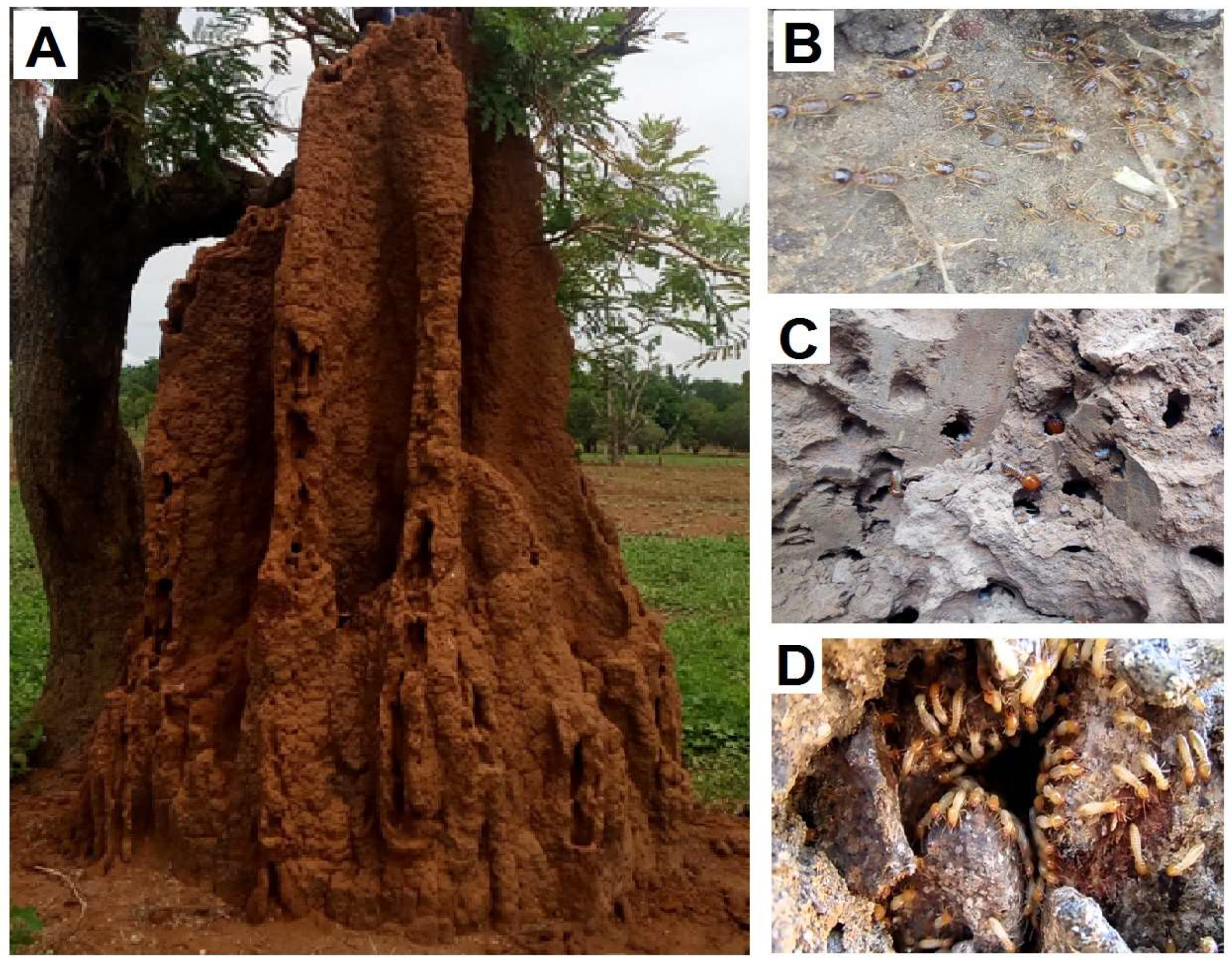
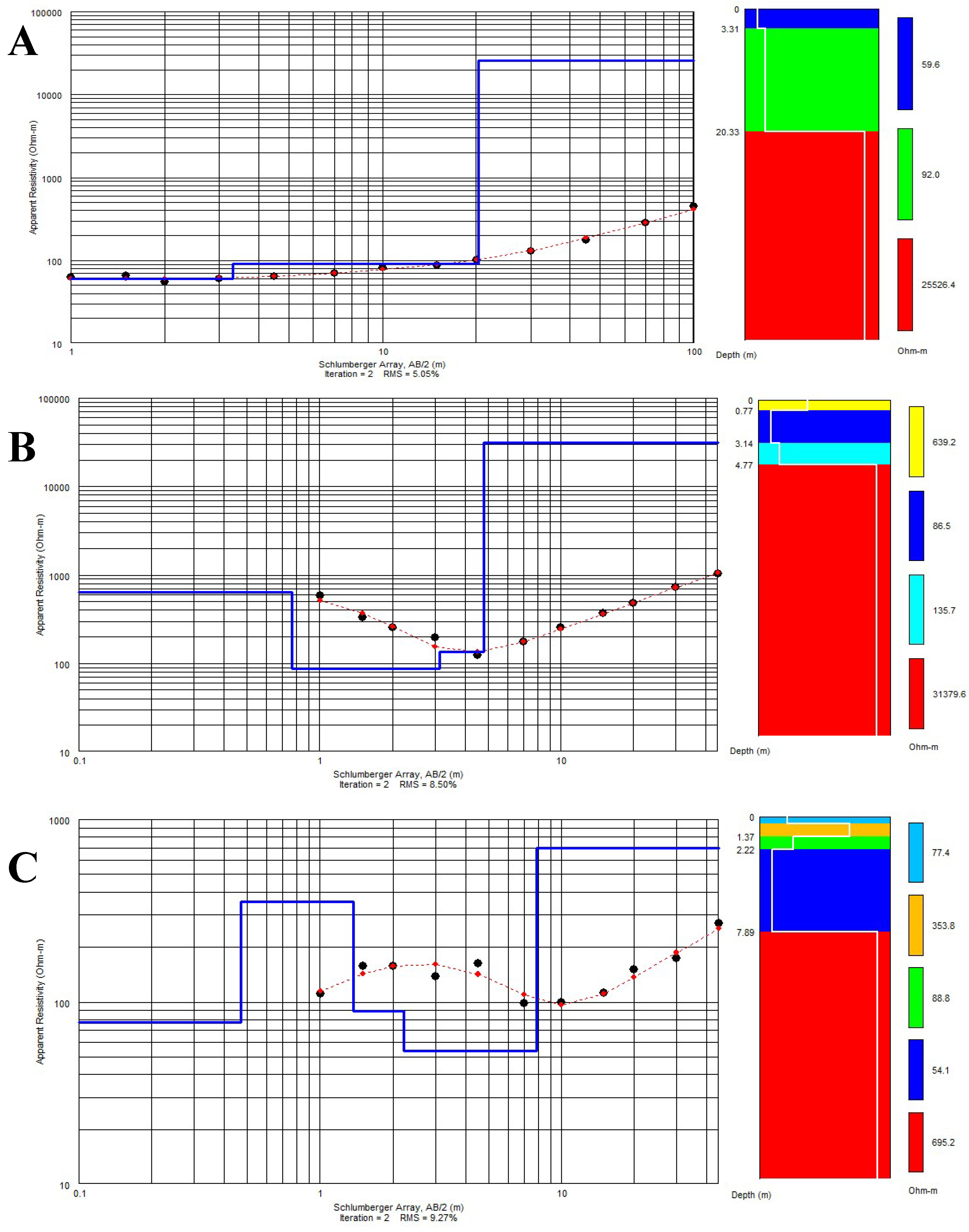
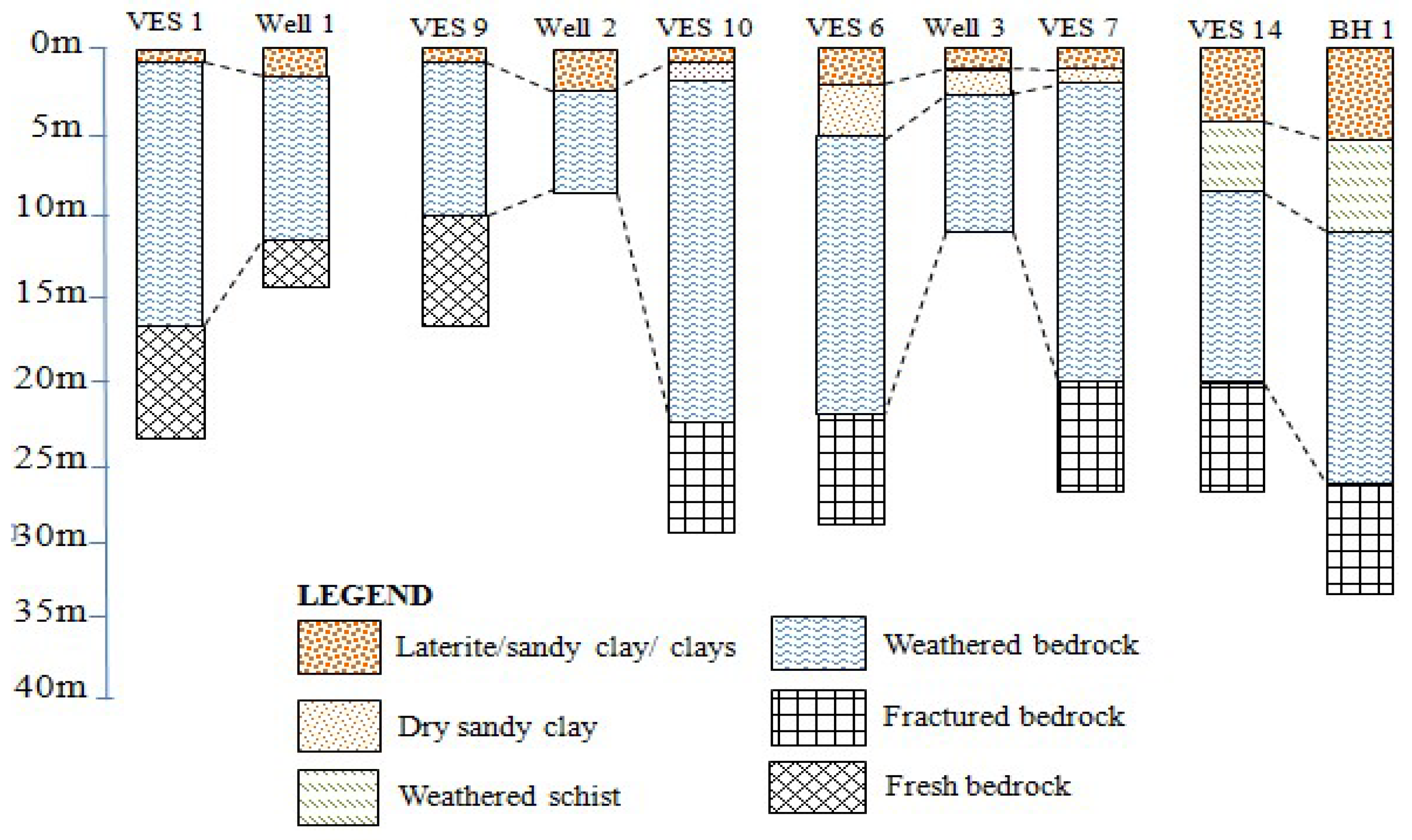
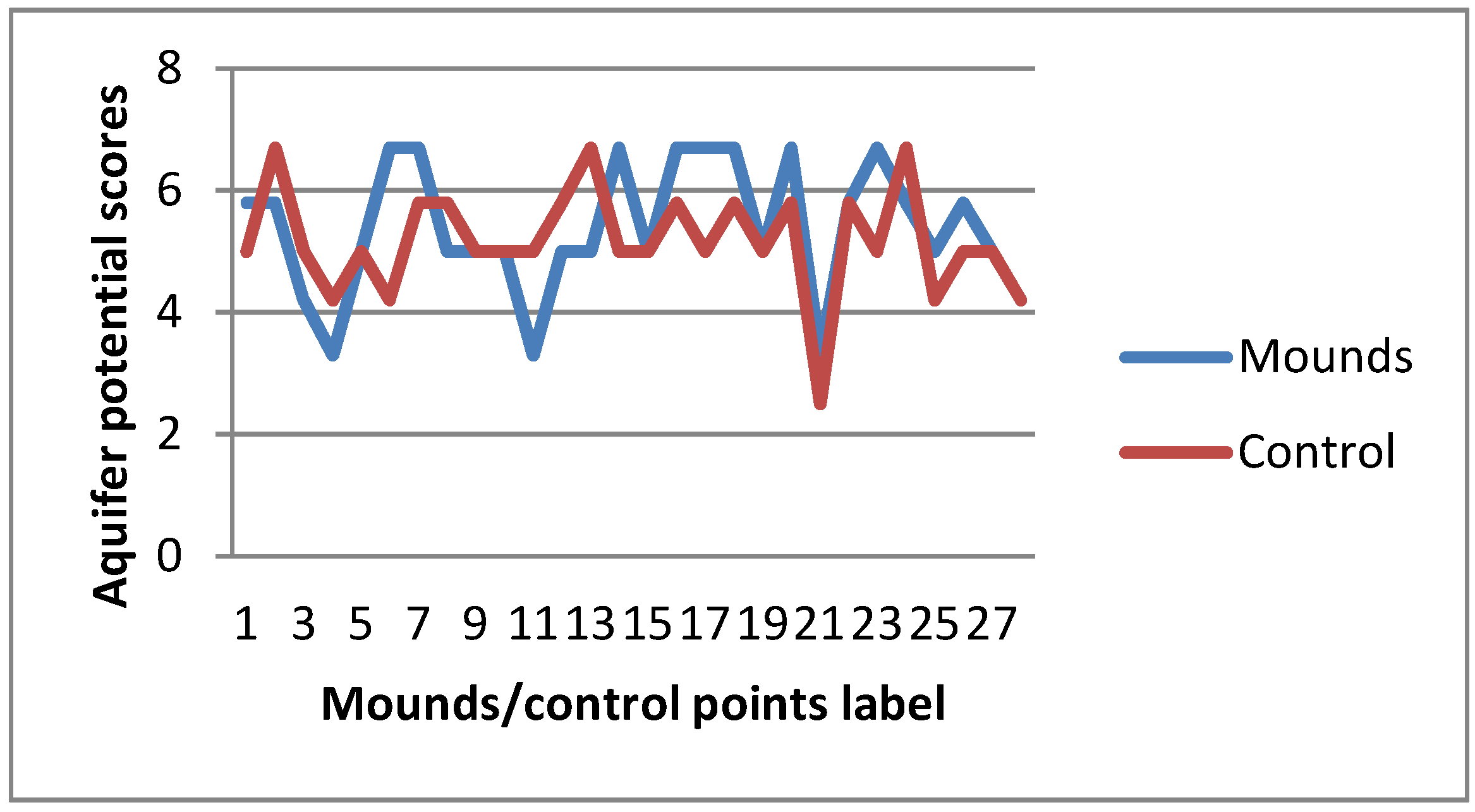
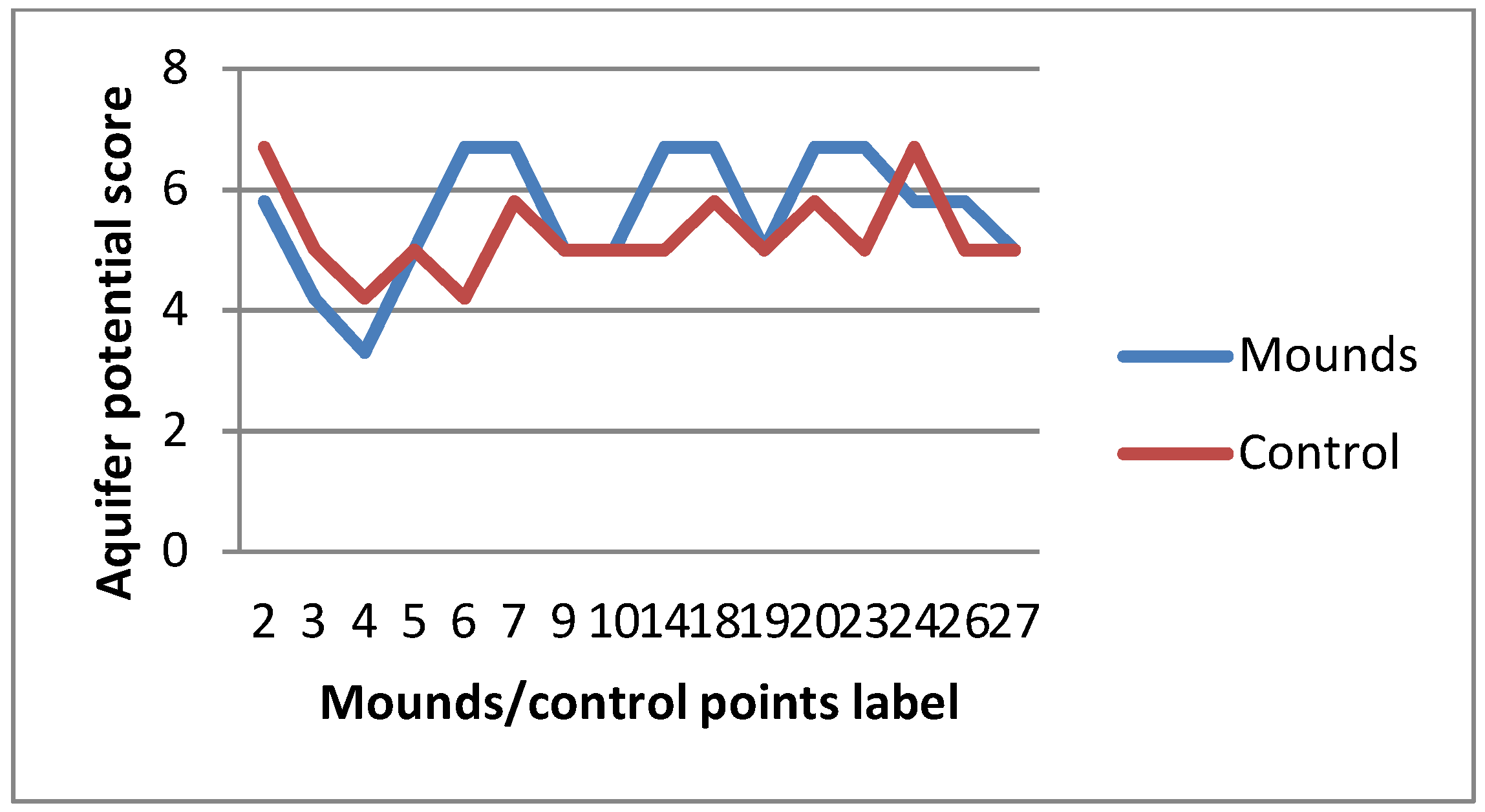
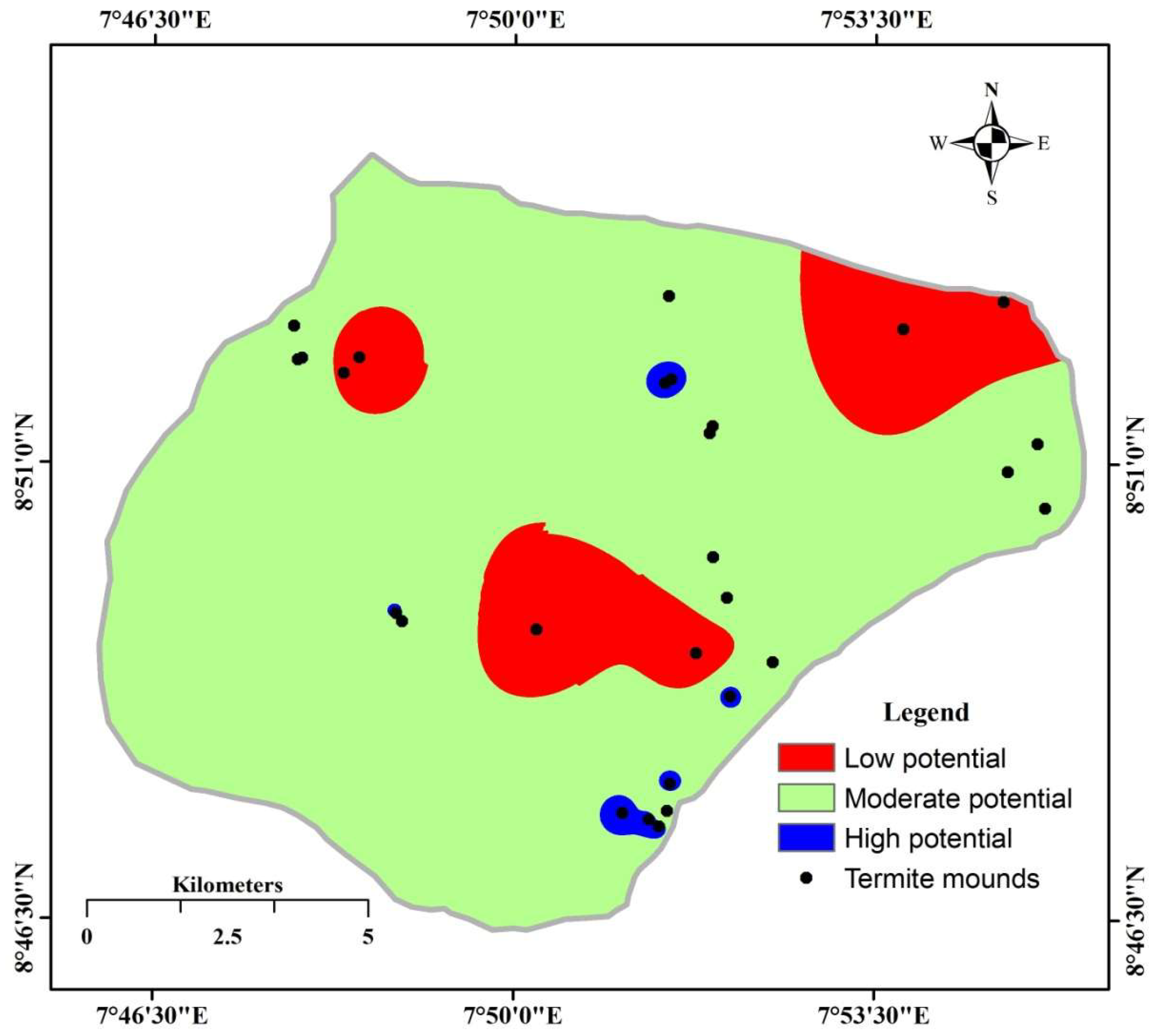
| Mound ID | Height (m) | Diameter (m) | Status | Species | Under Canopy? |
|---|---|---|---|---|---|
| TM-1 | 1.2 | 2.64 | Not active | - | No |
| TM-2 | 0.34 | 1.35 | Active | Macrotermes | Yes |
| TM-3 | 1.67 | 3.21 | Active | Macrotermes | Yes |
| TM-4 | 1.7 | 2.17 | Active | Macrotermes | Yes |
| TM-5 | 2.03 | 1.8 | Active | Macrotermes | Yes |
| TM-6 | 2.07 | 2.6 | Active | Macrotermes | Yes |
| TM-7 | 0.8 | 3.65 | Active | Macrotermes | Yes |
| TM-8 | 2.5 | 1.45 | Not active | - | Yes |
| TM-9 | 1.22 | 2.71 | Active | Macrotermes | No |
| TM-10 | 0.77 | 2.3 | Active | Macrotermes | No |
| TM-11 | 0.95 | 1.3 | Active | Coptotermes | Yes |
| TM-12 | 0.4 | 0.9 | Not active | - | Yes |
| TM-13 | 1.72 | 1.55 | Not active | - | Yes |
| TM-14 | 1.45 | 1.95 | Active | Macrotermes | Yes |
| TM-15 | 1.3 | 2.6 | Active | Coptotermes | Yes |
| TM-16 | 0.32 | 0.43 | Active | Nasutitermes | Yes |
| TM-17 | 0.42 | 1.03 | Not active | Nasutitermes | Yes |
| TM-18 | 0.64 | 2.6 | Active | Macrotermes | Yes |
| TM-19 | 0.77 | 2.1 | Active | Macrotermes | No |
| TM-20 | 1.62 | 2.38 | Active | Macrotermes | Yes |
| TM-21 | 0.3 | 0.9 | Not active | - | No |
| TM-22 | 1.4 | 1.97 | Not active | - | No |
| TM-23 | 0.98 | 1.07 | Active | Macrotermes | Yes |
| TM-24 | 0.8 | 4.52 | Active | Macrotermes | No |
| TM-25 | 2.77 | 1.67 | Not active | - | Yes |
| TM-26 | 1.34 | 2.45 | Active | Macrotermes | No |
| TM-27 | 2.65 | 1.8 | Active | Macrotermes | Yes |
| TM-28 | 3.1 | 2.55 | Not active | - | Yes |
| Theme | Depth (m) | Resistivity (Ohm-m) | Aquifer Characteristics | Weighting |
|---|---|---|---|---|
| Depth to bedrock | <10 | Thin regolith | 2.5 | |
| 10–20 | Medium regolith | 5.0 | ||
| 20–30 | Optimum weathering | 7.5 | ||
| >30 | Deep weathering | 10.0 | ||
| Weathered bedrock resistivity | <20 | Clays with limited potential | 7.5 | |
| 21–100 | Optimum weathering | 10.0 | ||
| 101–150 | Medium weathering condition | 7.5 | ||
| 151–300 | Little weathering | 5.0 | ||
| >300 | Negligible potential | 2.5 | ||
| Fractured bedrock resistivity | <750 | High fracture, high potential | 10.0 | |
| 750–1500 | Medium potential | 7.5 | ||
| 1500–3000 | Low potential | 5.0 | ||
| >3000 | Little or no weathering | 2.5 |
| Location | Particle Size Distribution | Bulk Density (g/cm3) | Porosity (%) | Infiltration Rate (mm/s) | Soil Water Content (%) | ||
|---|---|---|---|---|---|---|---|
| Sand (%) | Silt (%) | Clay (%) | |||||
| Termite mounds | 58.20 * | 26.01 * | 38.80 * | 1.93 | 27.3 | 39.36 * | 10.43 * |
| Control soils | 76.64 * | 16.92 * | 18.20 * | 1.94 | 26.7 | 17.64 * | 13.03 * |
| No. of Layers | Layer Resistivity (Ω-m) | Layer Thickness (m) | Regolith Thickness (m) | ||||||||
|---|---|---|---|---|---|---|---|---|---|---|---|
| ρ1 | ρ2 | ρ3 | ρ4 | ρ5 | h1 | h2 | h3 | h4 | |||
| 3 | a | 3.3 × 102 | 6.7 × 101 | 3.0 × 104 | - | - | 1.4 | 10.5 | - | - | 11.9 |
| b | 3.9 × 102 | 5.8 × 101 | 3.3x 104 | - | - | 1.3 | 4.1 | - | - | 5.3 | |
| 4 | a | 2.3 × 102 | 1.1 × 103 | 5.7 × 102 | 4.7 × 104 | - | 1.2 | 2.1 | 11.6 | - | 14.8 |
| b | 5.1 × 102 | 8.3 × 102 | 1.7 × 103 | 2.9 × 104 | - | 0.5 | 1.9 | 10.1 | - | 12.5 | |
| 5 | a | 3.3 × 102 | 8.3 × 101 | 3.8 × 103 | 1.6 × 102 | 8.0 × 104 * | 1.0 | 1.3 | 1.3 | 9.7 | 13.3 |
| b | 4.8 × 102 | 1.3 × 104 | 6.5 × 102 | 3.3 × 102 | 1.6 × 104 * | 0.6 | 0.9 | 3.1 | 5.3 | 9.8 | |
© 2019 by the authors. Licensee MDPI, Basel, Switzerland. This article is an open access article distributed under the terms and conditions of the Creative Commons Attribution (CC BY) license (http://creativecommons.org/licenses/by/4.0/).
Share and Cite
Ahmed II, J.B.; Pradhan, B.; Mansor, S.; Yusoff, Z.M.; Ekpo, S.A. Aquifer Potential Assessment in Termites Manifested Locales Using Geo-Electrical and Surface Hydraulic Measurement Parameters. Sensors 2019, 19, 2107. https://doi.org/10.3390/s19092107
Ahmed II JB, Pradhan B, Mansor S, Yusoff ZM, Ekpo SA. Aquifer Potential Assessment in Termites Manifested Locales Using Geo-Electrical and Surface Hydraulic Measurement Parameters. Sensors. 2019; 19(9):2107. https://doi.org/10.3390/s19092107
Chicago/Turabian StyleAhmed II, Jamilu Bala, Biswajeet Pradhan, Shattri Mansor, Zainuddin M. Yusoff, and Salamatu Abraham Ekpo. 2019. "Aquifer Potential Assessment in Termites Manifested Locales Using Geo-Electrical and Surface Hydraulic Measurement Parameters" Sensors 19, no. 9: 2107. https://doi.org/10.3390/s19092107
APA StyleAhmed II, J. B., Pradhan, B., Mansor, S., Yusoff, Z. M., & Ekpo, S. A. (2019). Aquifer Potential Assessment in Termites Manifested Locales Using Geo-Electrical and Surface Hydraulic Measurement Parameters. Sensors, 19(9), 2107. https://doi.org/10.3390/s19092107





